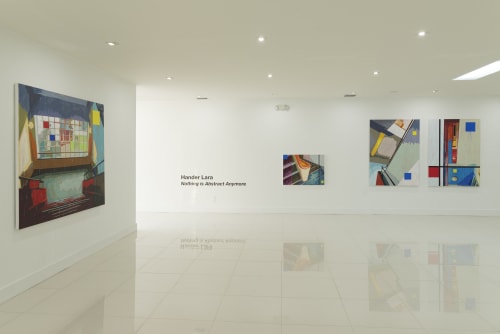In Hander Lara: Nothing is abstract anymore, the artist draws inspiration from the interior staircases of the Bauhaus, a cultural icon and pioneering center of art pedagogy. Seeking to blur the boundaries between art and life, Lara uses paint as his medium with nods to abstraction within a specific historicized context. Reflecting on the contemporary connection between abstraction and immediate reality, he observes how art processes have shifted towards a commitment to the contextual and experiential. Lara chooses the Bauhaus stairs as a motif, transitioning from the figurative to the abstract, from the evident to the suggested, and from the lived to the anecdotal, bridging past and present.
ARTIST TALK: HANDER LARA AT PAN AMERICAN ART PROJECTS (March 8, 2024)
Nothing is Abstract Anymore — Or is it?
Ross Karlan, PhD
Hander Lara’s most recent series, Nothing is Abstract Anymore, is more than a series of paintings, but a stunning visual essay. Rooted in deep research and first-hand experiences, the artist examines and reckons with the complexities of twentieth-century art at a time when form, function, color, and the very idea of representation were all called into question.
The axis around which Lara’s work turns is the Bauhaus, the famed German art and design school founded by architect Walter Gropius in 1919. The school was known for its cutting edge design principles in furniture, architecture, and the fine arts. Figures like Ludwig Mies van der Rohe, Wassily Kandinsky, Marcel Breuer, and Paul Klee, among many others graced the faculty and had lasting legacies in their fields. The Bauhaus closed its doors in 1933 as Germany saw the rise of Nazi power. However, during its brief existence, it sought to establish a new aesthetic of modern design, prioritizing minimalism, streamlined simplicity, and utility—a principle often attributed to Mies as "less is more.”
Lara looks specifically at the Bauhaus staircases, sites that he studied and photographed meticulously during his visits to the school’s building in Dessau. The stairways are, in a way, the artist’s protagonist on both a historic and symbolic level. Historically, Lara relies on the iconography of the stairways in a precedent established by painter Oskar Schlemmer who paints his own Bauhaus Stairway in 1932. His original version depicts the bustle of students ascending to class, and this work was even recreated years later in 1988 by Roy Lichtenstein.
The stairway also holds deep symbolic value for Lara and his own thought process behind the series. A stairway is inherently a means of transition, movement, and connection between two worlds. Lara reflects this sentiment in his own style, which moves seamlessly between figuration and abstraction, past and present, and even what is hidden and seen.
It can thus be said that stylistically, Lara aligns with the title of his series, employing only a minimal amount of abstraction to depict his scenes. While predominantly figurative, subtle abstractions emerge, referencing Bauhaus styles and palettes. Lara uses a visually strong brushstroke that may evoke the fuzzy brushwork of Paul Klee. Simultaneously, his brushwork possesses a distinct vertical nature, resembling drips across the image. Mixed with geometric forms and primary colors constituting the composition, it evokes the subtleties of constructivists like László Moholy-Nagy and Joost Schmidt. Lara even incorporates primary color geometric shapes into the works, subtly hidden in plain sight, contributing to the overall Bauhaus aesthetic
"Nothing is Abstract Anymore" surpasses the sum of its parts, demanding close attention to the details Lara includes for a profound understanding of the philosophical battle projected by the artist. Despite the abstractions at play, the works, when viewed from afar, are not abstract at all, they are the essence of an image composed of the artist’s interpretations and interventions. This mirrors the Bauhaus's balancing of the relationship between form and function; exemplifying the "chair-ness" of a chair, for example, involves both reducing it to its most essential minimal form and abstracting it from its historical predecessors.

